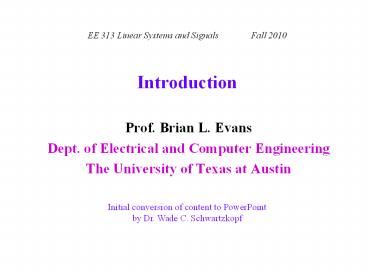Prof. Brian L. Evans - PowerPoint PPT Presentation
Title:
Prof. Brian L. Evans
Description:
DVD, digital cable, HDTV: MPEG 2. Wireless video: MPEG 4/H.263, ... Antenna array adds further increase in SNR & capacity by using spatial diversity ... – PowerPoint PPT presentation
Number of Views:49
Avg rating:3.0/5.0
Title: Prof. Brian L. Evans
1
Introduction
EE 313 Linear Systems and Signals
Fall 2010
- Prof. Brian L. Evans
- Dept. of Electrical and Computer Engineering
- The University of Texas at Austin
Initial conversion of content to PowerPointby
Dr. Wade C. Schwartzkopf
2
Coverage of Course
- Analysis of linear subsystems within control,
communication, and signal processing systems - Examples of electronic control systems?
- Antilock brakes
- Engine control
- Chemical processing plant
- Emerging trend brake by wire
- Examples of signal processing and communication
systems?
3
Signal Processing Systems
- Speech and audio
- Speech compression (cell phones)
- Speech synthesis and recognition
- Audio CD players
- Audio compression AC3, MPEG 1 layer 3 audio
(MP3) - Image and video compression
- Image compression JPEG, JPEG 2000
- Video CDs MPEG 1
- DVD, digital cable, HDTV MPEG 2
- Wireless video MPEG 4/H.263,MPEG 4 Advanced
Video Coding/H.264
Moving Picture Experts Group (MPEG)
Joint Picture Experts Group (JPEG)
4
Communication Systems
- Digital subscriber lines (DSL)
- Cable modems
- Cellular phones
- First generation (1G) Advanced Mobile Phone
Service - Second generation (2G) Global System for Mobile
(GSM) and Interim Standard-95 (Code Division
Multiple Access) - Third generation (3G) cdma2000, Wideband CDMA
- Fourth generation (4G) Long Term Evolution,
Wi-Max - Local area wireless Internet access
- IEEE 802.11a, b, g, n, etc. (WiFi)
Analog
Digital
5
Related BS ECE Technical Areas
Introduction
- Communication/networking
- EE345S Real-Time DSP Lab
- EE360K Digital Comm.
- EE371C Wireless Comm Lab
- EE372N Telecom. Networks
- EE379K-15 Info. Theory
- Signal/image processing
- EE345S Real-Time DSP Lab
- EE351M DSP (theory)
- EE371R Digital Image and Video Processing
- Embedded Systems
- EE345M Embedded and Real-Time Systems
- EE345S Real-Time DSP Lab
- EE360M Dig. Sys. Design
- EE360N Computer Arch.
- EE360R VLSI CAD
Spring
Fall
Fall
Spring
Spring
Spring
Undergraduates may request permission to take
grad courses
EE345S may be used for advanced laboratory
pre-requisite for senior design project.
6
Signals as Functions
- Function of an independent variable
- Temperature vs. time
- Closing value of a stock market vs. day
- Continuous-time signals
- x(t) where t can take any real value
- x(t) may be 0 for a given range of values of t
- Discrete-time signals
- xn where n ? ...-3,-2,-1,0,1,2,3...
- Sometimes use sample index instead of time
for n - Values for x may be real or complex
7
Analog vs. Digital Amplitude
- At each time value, analog signal amplitude takes
real or complex value (a.k.a. continuous-valued) - Digital signal amplitude takes values from a
discrete set (a.k.a. discrete-valued)
Analog continuous-time signal
Digital continuous-time signal
1
-1
8
Deterministic vs. Random Signals
- Deterministic signal amplitudes
- Can be mathematically described, e.g. x(t)
cos(2 p f0 t) - Random signal amplitudes
- Cannot be predicted exactly
- Cannot be described by a mathematical function
- Distribution of amplitude values can be defined
- Consider flipping fair coin (uniform
distribution) - Let 1 be heads and -1 be tails
Matlab/Mathscript Code flipnumber 110 y
sign(randn(10,1)) stem(flipnumber, y)































